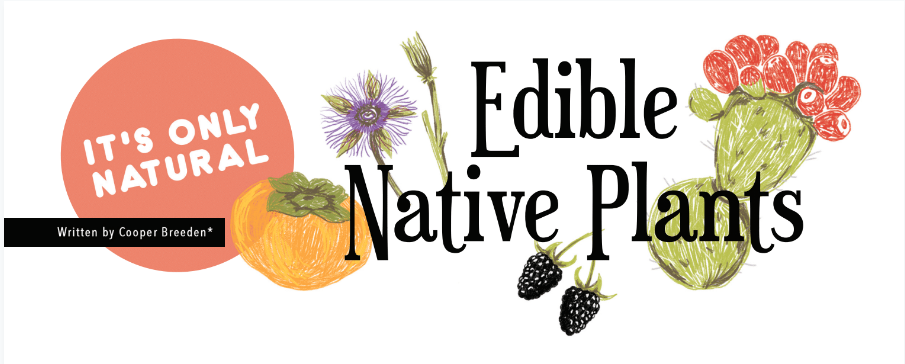
The fruits and vegetables we eat represent only a small portion of the plant kingdom. There is an edible world of opportunity in our backyards and the untamed land around us; we just have to know what to look for.
The concept of edible is somewhat open to interpretation—technically most things are edible, just with varying degrees of pleasantness and nutrition—and because of that the list of edibles is quite long. Of course some, like poison hemlock, are definitely not edible. But even some poisonous plants are edible when prepared correctly. For the purposes of this article, I’ve paired down the list to some fairly common native species. Also, I’ve only included fruits and flowers, no roots or tubers, so as to leave the plant intact. Lastly, because I must: don’t eat anything without confirming its identity with a professional. A few tasty-looking berries aren’t worth a trip to the ER.
As I write this in mid-May, many of the fruits we can harvest in the summer are budding or already in flower. Most obvious are blackberries, but there are many others that tend to grow alongside blackberries in sunny, weedy edges of fields and other open areas. For instance, the Tennessee state wildflower, purple passionflower (Passiflora incarnata), is a vine with strange and beautiful flowers that become a sweet, somewhat tart fruit ready for harvest in late summer and even early fall. The fruit is a couple inches in diameter and can be picked when it’s still dark green. Inside you’ll find a cluster of seeds covered in a sweet gelatinous goo. The seeds are harmless, but not that tasty—the goo is where it’s at.
Elderberries (Sambucus canadensis) also like the weedy, sunny margins. The flowers can be harvested in late spring or early summer and used for a variety of purposes (cocktails, pastries, salads). The fruit is typically cooked rather than eaten raw, because the seeds are poisonous in large quantities. Many people tend to confuse pokeweed (Phytolacca americana) with elderberry because they both have dark purple fruits. It’s important, and relatively simple, to learn the difference because pokeweed may grow in the same area and is poisonous. Some people do boil and eat pokeweed leaves, but it’s risky.
A few other summer fruits are worth picking, though they aren’t as prevalent as the three above. Staghorn sumac, or Rhus typhina, not to be confused with poison sumac, is a shrub that grows large, red, cone-like flowers in the late summer, which are often used in teas or lemonades to impart a citrusy flavor. Red mulberries (Morus rubra) produce a sweet blackberry-like fruit; you’ll know it’s ripe when it’s soft and dark red or purple. Other honorable mentions are berry-producing trees known as serviceberries (Amelanchier arborea), American plum (Prunus americana), and the prickly pear cactus (Opuntia humifusa).
When fall rolls around, there aren’t as many options, but that makes it all the sweeter. In my opinion, the best fruit one can harvest the whole year is the pawpaw (Asimina triloba), a small mango-like fruit that tastes similar to a papaya. Pawpaws are understory trees that grow near streams. I rarely find fruit on them, but that may be because the forest critters beat me to them. I’ve also heard they aren’t very effective at pollinating; some pawpaw growers hang raw chicken on the branches during the flowering season to encourage insects to visit the flowers.
Persimmons are another tasty fruit, but you have to get the timing just right—eating an unripe persimmon is like the cinnamon challenge, but with chalk powder. Basically, they’re best once they’re so ripe that they fall to the ground, and then you have to get them before they rot or get trampled on. Just try a nibble before diving in. Other tasty forest delights are muscadine grapes (Vitis rotundifolia) and hazelnuts (Corylus americana), though these will take a little more scouting.
One of the great things about foraging for edible plants is it’s free. For a head start, check out the iNaturalist app to see where others have found edibles. There are also a number of online resources that can help with identification, but if you end up getting really interested, I recommend getting an identification manual (email me if you need help picking one out). If you enjoy the outdoors, scavenger hunts, and/or eating, then foraging for native edible plants just might be your thing.
Cooper Breeden is a graduate student in biology at Austin Peay focusing on ecology and botany. Most recently, he led the river restoration program at the Harpeth River Watershed Association, and prior to that, he worked in fisheries management, watersheds and wetlands restoration, and philanthropy.



